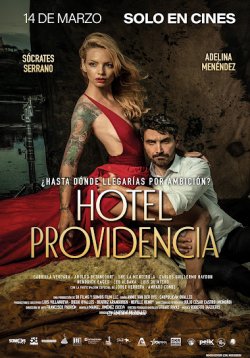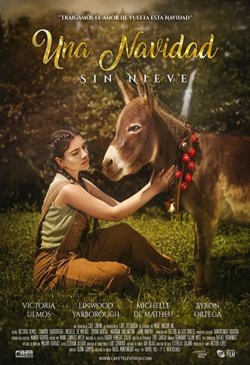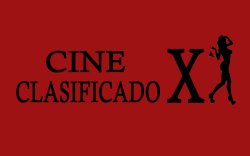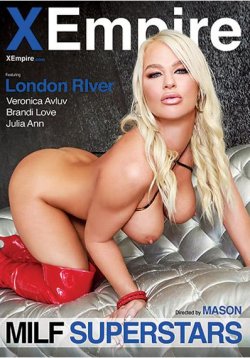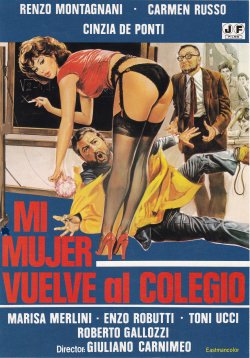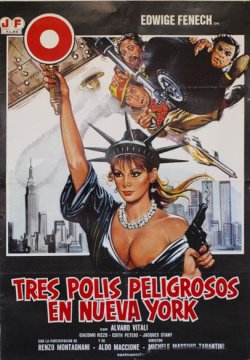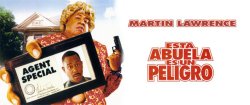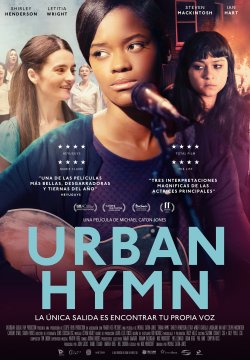 |
|
SINOPSIS
Durante los disturbios del verano de 2011 en Inglaterra, la historia sigue a una delincuente que posee una extraordinaria voz y de una trabajadora social que intenta reinsertarla...
INTÉRPRETES
SHIRLEY HENDERSON, STEVEN MacKINSTOSH, IAN HART, SHAUN PARKES, LETITIA WRIGHT, PAUL BLACKWELL, MARK HALDOR, RUSSELL BALOGH, DINO FAZZANI, McKELL DAVID
MÁS INFORMACIÓN DE INTERÉS
![]() CRITICA
CRITICA
![]() BSO
BSO
![]() CLIPS
CLIPS
![]() CÓMO SE HIZO
CÓMO SE HIZO
![]() VIDEO ENTREVISTAS
VIDEO ENTREVISTAS
![]() AUDIOS
AUDIOS
![]() PREMIERE
PREMIERE
 GALERÍA DE FOTOS
GALERÍA DE FOTOS
https://www.cineymax.es/estrenos/fichas/120-u/99738-urban-hymn-2015#sigProIdb78684f666
 INFORMACIÓN EXCLUSIVA
INFORMACIÓN EXCLUSIVA
Nota: La compañía distribuidora no nos ha facilitado el material en castellano
THE INSPIRATION AND HISTORY BEHIND URBAN HYMN...
Screenwriter and executive producer Nick Moorcroft was always inspired by filmmakers like Mike Leigh, Ken Loach and Alan Clarke, “When I was a young teenager I loved Made in Britain, Scum and The Firm. I wanted to write films like that. But it wasn’t until I’d had some opportunities to write more commercial movies, that I felt that I was in a position to write something more personal”.
'Urban Hymn' draws on a lot of Moorcroft’s own experiences as he explains, “I was a young offender. I got into a lot of trouble with the police. I was in the court system, I got expelled from school to the point where no school would take me in my area. I was eventually home-schooled by the council, which was a disaster. I was diagnosed with ADHD so they pumped me full of Ritalin. I was probably one of the first guinea pigs to go on those drugs and they had the opposite effect - I think it made me crazier. But what was interesting about that period was I had a very, very strong parental figure in my mum. She showed me such commitment and a level of unconditional love, I’m now aware as an adult I was very lucky to have her”.
Moorcroft’s mother supported him throughout that turbulent period in his history, which as he admits, “was very tough on her”. He also acknowledges that without her “I would definitely be serving a long prison sentence. Out of my ten closest friends during that time, five have been to prison more than once and one is currently serving a twelve year sentence”.
Using that strong bond with his mother as the inspiration, Moorcroft crafted it into the core storyline and during the course of his research he decided to set it within the care system. It was another area he had personal knowledge of, “I was never in care but one of my mother’s friends ran a residential care home in Romford in Essex where my Nan lived. I saw that these kids were without the kind of parental figures I had to get me through those bad times. I took that as inspiration”.
Setting Urban Hymn in a residential care home, Moorcroft liked the concept of a child without a mother (Jamie) and a mother without a child (Kate), “You have two people dealing with their own grief. Kate has lost her only son and Jamie has lost her mother to a heroin overdose. So, it felt like I had the framework to build a story. “It was very cathartic and obviously Jamie became a kind of a composite of myself and my personality and other people I grew up with”.
Moorcroft’s original screenplay was called Riot Girl and it was, as he admits, “tough, relentless and there wasn’t much redemption to this story and it was also very violent”.
David Thompson, who was the head of BBC Films at the time, read Riot Girl and he really liked it. It was Thompson who suggested to Moorcroft, that perhaps Jamie could have a talent, but Moorcroft admits, “I wasn’t ready to listen to smart advice at that point and the draft just got put in a drawer”.
Following the success of the St Trinian’s franchise with Ealing Studios, Moorcroft wrote Burke and Hare and started to get some big commissions in Hollywood at Columbia Pictures. Projects included a modern day Treasure Island for producer Neal Moritz and A Lion Called Christian for Matt Tolmach and John Lesher. Despite his success, Moorcroft increasingly felt in a development bubble, “It’s that place where all screenwriters become very disillusioned”. Moorcroft and his partner Meg Leonard had recently become parents, her for the second time and she got to thinking about the importance of a maternal figure in a child’s life so she suggested Moorcroft take another look at Riot Girl. He pulled it out of the drawer, dusted it off and he admits “I realised that David Thompson was right”.
Recalling how music played an integral part in his own rehabilitation, Moorcroft used that as inspiration and gave Jamie the lead girl her voice. The idea spiralled when he brought in unconventional care worker Kate, who ultimately comes into this system to try and understand and help the kind of kids who murdered her child. Kate belongs to a community choir, and she recognises how music is a release for Jamie. “We then had to find ways to create more obstacles and a lot more drama, so I introduced the role of Leanne who is based on someone I grew up with”.
Jamie, Kate and Leanne create a triangle Moorcroft recognised from his own youth, “There’s often that conflict growing up, where you’re aware of this perverse loyalty towards people. I would put my liberty at stake because of a bond and I was prepared to do things despite the consequences. But there comes a point where you have to make a choice. My choice was whether or not to end up in a young offender’s institution. I had some really close calls and finally I was in court on this occasion I’d been told to prepare to go to Feltham Young Offenders Institution and I was absolutely terrified. I was confident but I knew if I went to Feltham where my friends had been, it was going to be a tough place for me”.
Meg Leonard, Moorcroft’s partner had provided the initial encouragement to resurrect Riot Girl and she became his development executive and script editor on the project in its new form. Leonard became acutely aware of the social relevance of this story in the aftermath of the London riots as she recalls, “I felt like the youth were being written off. Disenfranchised youths were being denounced by politicians. Our story is one of hope and redemption, it gives a voice to people who feel alienated and unrepresented. We should try and understand individual stories, not lump people together in a mass and write them off”.
“It was a fantastic collaboration with Meg. What started out as very youth orientated movie became more mature. We were telling the adults’ stories as much as the kids” notes Moorcroft. They also became aware of certain influences and references such as Menace to Society and Boyz in the Hood, two films about south central Los Angeles, dealing with the same kind of issues. “I was very conscious that I wanted to tell a redemptive story, showing that there is a way out and there is hope. It’s no fairy-tale, Jamie goes through a hell of a journey but she has to overcome those obstacles and she is presented with a chance. Lots of people in life are presented with chances, but you’ve got to have the ability to acknowledge the chance, accept it and then ultimately change yourself to be able to make it work for you”.
“At the end of Urban Hymn there’s a sense of hope. Jamie is still singing, she’s still alive, and she’s not in jail. She’s made new choices about herself and about the future” concludes Moorcroft.
A major turning point in the Urban Hymn journey came when director Michael Caton-Jones boarded. Moorcroft had sent the screenplay to both his British and US agents. Even though it seemed a long shot expecting Abram Nalibotsky, his US agent to respond to an inner city London-centric story, his agent surprised him and said he really loved it and he thought one of his directors, Michael Caton-Jones, would also respond well too.
Moorcroft was both shocked and thrilled at this news, “Michael’s directed some of my favourite films like, Rob Roy, This Boy’s Life and Memphis Belle. These were really early cinematic experiences for me growing up and I just thought, it’s never going to happen”. A week later Caton-Jones confirmed he was in and refreshingly, he felt it was a complete script and he didn’t want to change the structure but he did feel he could bring new elements to the table, elevating it into something bigger and he encouraged Moorcroft to make some braver choices, “I think a writer’s worst fear is that a director comes on board, starts playing around and it gets caught in development hell, then the director loses faith and belief in it and moves on” comments Moorcroft.
Caton-Jones flew out to Moorcroft and Leonard’s home in France and the trio spent eight hours a day, going through the script meticulously line-by-line for a full week “It was a fantastic experience and we were pretty much done by then” recalls Moorcroft.
Choosing the right actors to bring the screenwriter’s character creations to life, is always an interesting process and as Moorcroft points out, “It was always going to be challenging to find young actresses to play the roles of Jamie and Leanne. Jamie goes on a huge journey and she’s somebody who finds it difficult to trust and to let people in. She’s dealing with a profound sense of grief over the loss of her mother and she has a deep-rooted loyalty towards her best friend Leanne. She has to learn to trust somebody within a care system that doesn’t lend itself to trust. Letitia Wright has really nailed all of that in bringing the character to life. You feel empathy and love for Jamie as a result. As an actress, she’s had to play volatile, temperamental, but also deeply sensitive and deeply emotional. As the writer, I’m thrilled with Letitia, she’s more than I could ever have hoped for”.
“Leanne is based on somebody I grew up with and I never thought we’d find an actress who could be that imposing and threatening in such an understated way. When I saw the casting tapes of Isabella Laughland, I thought, ‘Wow!’ I heard her speak and it was just remarkable, to hear her real accent compared to what she’s doing with Leanne. It’s just a testament to her ability as an actress. I was just blown away. You also feel empathy for her, because she’s the ultimate best friend who would fight your corner to the death, yet there’s another aspect of that friendship where she’s also the most destructive force in that girl’s life. A lot of friendships do come to an end, and it comes to an end in this film in a very tragic way”.
FROM SCRIPT TO SCREEN...
A chance meeting on a plane set the wheels in motion on the film’s financing for Urban Hymn screenwriter Nick Moorcroft. As a result he was put in touch with producer John Sachs, “John’s name rung a bell with me” explains Moorcroft, “so I checked him out and realised he’d had a very long and successful career in television and had recently joined forces with a company called Eclipse Films which was set up by producers Neil Chordia and Andrew Berg and their chairman was Brian Berg, a very successful music guy from Universal who’d sold millions of records”.
Moorcroft and Sachs spent an hour and a half on the phone initially and Sachs talked about Eclipse’s slate of projects and explained how they were looking for musically driven projects, Urban Hymn seemed an obvious fit so Moorcroft immediately sent the script across to him and Sachs optioned it the very next day, “That was in February 2014 and we started shooting in September 2014, so it came together very quickly, and that is down to not only Eclipse’s determination to make it, but to Anwar Kawadri and Ibrahim Dashishah who 100% financed the film through their Swiss-based company. Without them, this kind of film wouldn’t get made, so obviously I’m eternally grateful to them” says Moorcroft.
“I absolutely fell in love with Nick’s script” recalls Sachs, “so I sent it to my fellow producers, Neil and Andy and they loved it as well. I then sent it to Trevor Green at Entertainment Film because he’s a friend and I just wanted to get his opinion as a distributor if he felt it had legs. Trevor read it very quickly, thought it was amazing, and asked if he could send it to a friend who was looking for films around this budget”.
The upshot of this chain of events between Sachs and Green brought Anwar Kawadri into the mix. Kawadri is the gatekeeper to Dashishah Global Film Production, a Saudi company based in Geneva. The result – an offer to finance Urban Hymn 100%.
“I think that’s one of the fastest offers I’ve ever heard of” says Sachs, “it was extraordinary and six months later, we’d shot and wrapped the film”.
For the producers, one of the elements of appeal with this project is the strength of the female trio the story focuses on, “The more I read and I engaged with it I saw this incredible interaction between these three women. Men don’t matter here, it’s about the women and we see both good and evil” notes Sachs. “Kate is still nursing the wounds from her own son having been mugged and murdered. She’s dealing with it in her own way and she doesn’t refer to men and nor do Jamie or Leanne in their journeys”.
Producer Neil Chordia echoes these sentiments, “The female characters in this are very, very strong but in different ways. Kate has been through an enormous amount of tragedy but still has it within herself to see a way to put these kids on the right track. Leanne is a great character and strong in her own way but perhaps much more in a physical way and a much more dominant way. There’s a great scene where Jamie has her guitar taken away from her in prison and Leanne's first instinct is to stick up for her and go and beat up the bullies who took it. The women have very different styles. Jamie has this passion for music and an inner strength to want to turn her life around and ultimately to have the courage to pull away from Leanne when she has to”.
“It’s a rarity to see three female leads driving a story” notes executive producer Meg Leonard who also worked with Nick Moorcroft on the development of the script. “None of their paths are dependent on male influence. In France where Nick and I now live, they have a saying ‘If you look after mothers then you look after society’. The whole role of the maternal instinct and the unconditional love of a mother is so relevant in this story”.
For producer Andrew Berg, one of the key themes that drew him in was the idea of the wayward teens and the lack of support system in place for them, “You basically have these kids who go from care home to care home and they don’t get the proper attention that they ought to get in dealing their struggles and the trauma they’ve gone through. The 2011 riots are obviously the introduction to the piece and as I was living in London then, I recall it being a very frightening time. However, this film offers a very interesting take on the actual problem and the government’s stance at the time. This film shows just how deep those underlying problems go into the youth culture today. In our story, Jamie and Leanne only have each other to rely on. When Kate arrives, she suddenly gives Jamie the adult support that she’s always needed and that completely changes her outlook on life and she takes opportunities rather than throwing them in people’s faces”.
Realising these characters on their painful and joyous journeys needed to be crafted by a director who was sensitive to both the power and fragility of these women. Producer Andrew Berg was thrilled with what director Michael Caton-Jones brought to the table as he explains, “Michael just has an amazing vision and he’s such an incredibly intelligent guy. His portfolio of work is just so impressive. Scandal is one of the first films I remember watching, so for me having Michael Caton-Jones is just great. When he talks about the layers of this script and how he seems the characters, I just knew he’d deliver something to be proud of”.
Producer Neil Chordia’s response after first reading Urban Hymn was to send producing partner John Sachs an email saying, “This is now the benchmark for the type of script we are going to look for”. Chordia was equally thrilled that the quality of the script attracted a director of Michael Caton-Jones’ calibre as he confirms “I don’t think Michael was initially on our radar when we were looking for a director, simply because as a small independent film, we didn’t think we’d have a shot with someone who’d been working in Hollywood with such a résumé. Bringing all that wealth of experience has been huge for us”.
ENTREVISTA AL DIRECTOR...
How did you get involved in this project?...
.- I was sent Nick’s script by my agent in California and I was expecting a little streetwise movie, but when I read it I found there was an awful lot more to it than that. There were a lot of elements that could potentially make a really good film. It was the quality of the script that attracted me.
What was the specific appeal of it?...
.- I’d been doing Hollywood films for some years and I was kind of tired of the ‘by committee’ way that they were made. More money doesn’t always mean a better film. Urban Hymn was something I felt I could do quite quickly, quite cheaply and I could make a good little movie, it was really as simple as that. It was something I could have some control over and I could get back to way that I started making films, which was a big attraction for me.
What were the central themes of the story that appealed to you?...
.- There were many elements in the screenplay that I thought gave it the potential to be a really interesting film. It had three central female protagonists and I liked that because you always hear in this business that they don’t make films with strong female characters for women anymore and I felt this film was bucking that trend. The story also had a lot of music in it and it’s been a while since I’ve done something like that and music is something that’s big to me. The quality of the characters, the backdrop, the music and the emotion were a big draw. Also, the fact that the three characters occupied different colours in the spectrum and they all had something interesting to say. It wasn’t a female empowerment film, which I find slightly clichéd. The women were rounded characters, they all had different facets to them, good and bad and I felt that reflected what I feel any human being’s got whether they are female or male.
Once you were on board, did you have any input in refining the script?...
.- Whenever you pick up a script there are good elements and those that are working less well. Nick was very good to collaborate with. We went through it with a fine toothcomb, and it was an extremely productive process. He’s a good writer and he and Meg had done a good job, but there were elements I felt weren’t stressed as strongly as they could be, so I began chucking out loads of ideas and we then worked them up into scenes and character strands. As a director you simply shape it to what you think it could be, and that allows good actors act and good technicians to contribute.
Take us through the casting process...
.- We didn’t have much money to make this film so we couldn’t throw buckets of money at actors, so instead, we had to find ones who were really committed to the character and committed to doing a low budget film. So, when I was looking for someone to play Kate, we had to find someone who’s was gagging to do it. I spoke to Shirley Henderson because I’d worked with her on Rob Roy and it was one conversation on the phone and she was in. She really was up for it. The great thing about Shirley is, apart from being a really good actress, she’s a complete team player. There was no hysteria around her, which can often happen and that derails the process to a certain extent. With Shirley, we had this one long conversation and realised that we felt quite similar about who the character Kate was and where she was going. Shirley brings a level of quality acting-wise to something like this and she gives a kind of moral centre to the piece. My admiration for Shirley really grew in the filming of her. I was a bit of a fan beforehand but now I’m ecstatic about her ability and really it was a great pleasure working with her.
To cast the other two lead characters, was slightly different because we had to find girls of a certain age and of a certain type. It was never initially written with any colour or skin tone in mind, but when Letitia read for me, she’d actually come in for the character Leanne and I was like ‘Wow, you’re really good’.
When you’re casting you have to see the bigger picture and the overall tapestry, so you need different types of people for that. I filed Letitia in my back pocket and I was reading with other girls for the part of Jamie, many of whom were pretty good but they weren’t quite dominating it. We were getting closer to our shoot date and casting the right leads was crucial. I was given a self-tape audition from a girl who was in Australia. It was Isabella Laughland. For that reason Izzy always be ‘the Australian girl’ to me, even though she was only there on holiday.
Luckily I had a light bulb moment with the idea of switching Letitia and Izzy around from the roles they’d read for. It’s almost like a chemistry experiment, you take these different elements and you put them together and you don’t know quite what the reaction is going to be. We were very lucky, we found these girls and when they met and they read together, they were like best mates in an instant. It was only with the commitment of Shirley, Letitia and Izzy that the thing began to take shape, and it happened in the last week or so before we started shooting.
Letitia said she hadn’t experienced working with a director who gave her so much technical information about the filming process. Can you talk about that?...
.- I feel that it’s everybody’s responsibility to pass on knowledge especially in this day and age. If you’ve got something it’s not something to be protected and kept, it’s something to be used to enrich everybody. I often find with younger actors, they’ve not really had a great deal of experience in front of the camera. Letitia and Izzy had, but it’s only by seeing them on a daily basis that you can tweak them in a way. It’s never explained to them what size of shot it is, what intensity you want them to achieve and I’m quite articulate about that. I could explain why, so that they would then start to think about it before they came to set. The first week is almost like a training thing where you introduce them into the way that you shoot and what you expect from them. I’m quite demanding as a director in that way. I don’t want my actors to just to turn up and think they can do what they did on some TV show. It’s much more serious than that. You have to, you know, making a movie for the big screen is a very privileged position and you can’t just turn up and do it, and once you get them to understand that, their mind just expands. Every look and every gesture and every reaction has to be thought through and it has to be done for a reason.
On this film, I did what I’ve done with many actors in the past, especially young ones. You try and educate them a bit and hopefully they then take that on and it makes them a better actor. A big part of the filmmaking process is about taking responsibility for your actions, which is a kind of maturation process. I’ve been lucky to have been helped throughout my career by people giving me advice or teaching me. A lot of technicians and cameramen have helped me and taught me a lot and I feel as though that’s what should be passed on. It also chimed in with what I felt the theme of the story was: if someone offers you a hand you have a responsibility not to ignore it, not to walk away from it, not to laugh at it, but to actually listen and give it its due worth and hopefully make yourself a better person and hand it onto someone else. I believe in that quite strongly.
Letitia said she hadn’t experienced working with a director who gave her so much technical information about the filming process. Can you talk about that?...
.- I feel that it’s everybody’s responsibility to pass on knowledge especially in this day and age. If you’ve got something it’s not something to be protected and kept, it’s something to be used to enrich everybody. I often find with younger actors, they’ve not really had a great deal of experience in front of the camera. Letitia and Izzy had, but it’s only by seeing them on a daily basis that you can tweak them in a way. It’s never explained to them what size of shot it is, what intensity you want them to achieve and I’m quite articulate about that. I could explain why, so that they would then start to think about it before they came to set. The first week is almost like a training thing where you introduce them into the way that you shoot and what you expect from them. I’m quite demanding as a director in that way. I don’t want my actors to just to turn up and think they can do what they did on some TV show. It’s much more serious than that. You have to, you know, making a movie for the big screen is a very privileged position and you can’t just turn up and do it, and once you get them to understand that, their mind just expands. Every look and every gesture and every reaction has to be thought through and it has to be done for a reason.
On this film, I did what I’ve done with many actors in the past, especially young ones. You try and educate them a bit and hopefully they then take that on and it makes them a better actor. A big part of the filmmaking process is about taking responsibility for your actions, which is a kind of maturation process. I’ve been lucky to have been helped throughout my career by people giving me advice or teaching me. A lot of technicians and cameramen have helped me and taught me a lot and I feel as though that’s what should be passed on. It also chimed in with what I felt the theme of the story was: if someone offers you a hand you have a responsibility not to ignore it, not to walk away from it, not to laugh at it, but to actually listen and give it its due worth and hopefully make yourself a better person and hand it onto someone else. I believe in that quite strongly.
Let’s talk about the journeys of the individual characters...
.- Jamie probably has the biggest journey to take in the film. She starts off not really thinking about tomorrow, not really thinking about anything beyond surviving or instant gratification or whatever’s in front of her nose. It’s also a function of age, and it’s a function of circumstance. Her circumstances are not great at the beginning of the film and it’s really through exposure to someone else, to someone from a different background and someone with a different world view that allows her to see things through new eyes. What she thought was dangerous or offensive or something to be avoided, she begins to realise that we’re all in the same boat. If someone’s being nice to you, they don’t necessarily want something, they just, they’re doing it because that’s the way they’ve been brought up and that’s the way they feel. That’s a background and a backdrop that Jamie has never experienced. She has the longest journey to go through and none of it’s a straight line, it’s up, it’s down, it’s backwards, it’s sideways, which is what makes it interesting.
Jamie’s journey is very personal to her and I think it’s very rewarding to watch someone go through that because you start to root for them and you start to recognise aspects of your own life and you begin to empathise. What you are trying to get out of anybody in a film is for an audience to be empathetic about the situation and what the character’s gone through. You try and present situations in as honest a way as possible so that an audience will recognise that and then they will become more attached to the film. I feel her journey is hopeful, not necessarily easy and it’s not necessarily finished by the time the film ends.
What is Kate’s journey?...
.- Kate, to me, has a fascinating journey. She was the one Nick and I worked most on in the writing phase. It was very interesting to see someone who apparently had it all, or had achieved a certain status in life and a certain financial comfort and a certain place in their life. From the outside you could say, ‘Well she’s lucky, why’s that not me?’ But through the process of watching you realise what’s on the outside is not necessarily what’s on the inside.
Kate is a woman who’s actually had some pain in her life and she’s kind of hanging on by the fingernails. It’s a real indication that you can’t judge a book by its cover, and certainly not by the way your preconceptions and prejudices present someone to you. Her journey is one where she’s battling her internal demons to try and get through every day. I think it’s a very common experience where you try to be good but you end up not being necessarily good and sometimes you go, ‘Oh the hell with it’, then sometimes you think more altruistic thoughts. Nobody’s ever all good or all bad and people do things for certain reasons.
In some ways Kate is a very selfish woman, she’s doing things to satisfy herself but what she wants is a different path and that’s a function of age as well. In this story, you’ve got two different generations, they have different viewpoints on the world and what’s interesting is how they come together and how they try and reconcile the fact that they have completely different world views and achieve some kind of understanding of who they are. I find very interesting because she’s much darker than she seems on the outside.
How about Leanne’s journey?...
.- Leanne’s character and journey is again a reflection of aspects of who we are as people. She’s quite hedonistic. She doesn’t suffer fools gladly or easily. She doesn’t take any nonsense from anybody and she tells it like it is. Leanne has very little filter going on and that is apparent when she opens her mouth. We all know people like that. They’re kind of dangerous and they’re kind of attractive at the same time. The question is what balance can you get from that? It’s exciting to be in the company of someone who’s alive and aware and awake, but it can also lead to a hell of a lot of trouble for you if you’re not careful. If someone like that is your best friend, there’s a push-pull going on about what you know isn’t good for you and what you know you shouldn’t do, and what you feel you have to do because of the past that you’ve gone through together.
I feel that scenario is very common with a lot of young girls because their connection with each other is very strong. At that age, it can lead you into damaging places if you’re not careful. So Leanne is that kind of unfiltered force of life, and what’s interesting, is that it’s like chemistry, you’re trying to put these three different characters together and see what sparks come off them. I think we managed to do that very well in the shape of the screenplay and the narrative. But also we’ve reinforced that with the casting of these particular women in these roles. I just think the three of them are incredible. I’m so in love with them, I think they’re just brilliant.
Would you say there’s a kind of love triangle going on between Jamie, Leanne and Kate?...
.- There is. Not a Sapphic love triangle, it’s much more a mental thing that’s going on which again is peculiar to women. Men punch each other and shout and that’s it. Women torture each other and they love each other, so their emotions are stronger and their feelings towards each other are more nuanced. That’s what I was after finding in this story, a more nuanced portrait of three women.
There’s definitely love, rejection and jealousy and a whole tumble of emotions going on from the three of them at different points. Again, that’s life and that’s what I’ve found interesting.
Can you talk about the look, feel and the style of this film?...
.-Any film is dictated by how much money you’ve got to make it, and we had very little. But that’s not necessarily a bad thing. In this instance I refused to let our financial limitations dictate that something should not look good or shouldn’t be done professionally. There’s no reason for that if you think it through properly. We couldn’t afford certain things so we couldn’t have them, but I wasn’t going to cry about that, you just have to think of a different way. In many ways those constraints lead you to think better, you have to think your way out of trouble rather than buy your way out of trouble. It was painful at first but it became exhilarating after a while. The speed we had to shoot and the amount that we had to shoot was just incredible (and now I’m sitting here I don’t know how we did it!
We had to hit the ground running on the first day and we didn’t stop until the 27th day and that was it. In between times, things inevitably do go wrong and you just have to keep moving. If you didn’t shoot, it wasn’t in the film and we couldn’t afford to go and pick it up again. We had half an hour before we wrapped every day and we’d look at what we had left and we just went twice as fast and cut the shots down, you did one take and you moved on.
When you have three amazing actresses, who were well-rehearsed, who had worked the script, you knew it was working. Much of the film was shot that way and it gives spontaneity and an incredible inventiveness because everyone’s under the same pressure. Having a fantastic crew and a cast who just excelled all the time in tight corners made it what it is.
With regard to the actual look and style, I wasn’t going to approach it as a hoodies on the estate film. It wasn’t, I wasn’t interested in that. There were two different looks that I was after. One was the look that the girls’ world occupied and the other was Kate’s world and I tried to tell them in different ways because every aspect of the filmmaking process is useable to tell the story, with colours for instance. We couldn’t afford to build sets, we had to find locations. What we could afford to do was paint them and we changed the colours to suit a colour scheme that we had throughout. So in that way you control the mood, you control people, what people take out of it to a greater extent simply by utilising a colour scheme that is quite disciplined.
The cameraman, Denis Crossan, I’d worked with many times before, and we had a very good shorthand, we don’t talk much, we just set the shot up and he’s say, ‘Well how is it?’ and I’d say ‘Aye that’s okay’ and it would be done because we were at film school twenty-five years ago so we know each other very well. Denis is a fantastic cameraman and what we were after was a naturalistic feel. There are different ways you can show that as well. With the girls I did a lot more handheld and with Kate I did more formal filmmaking. The compositions and the camera moves were much more controlled with Kate and in a way that reflects her life and the edginess of the handheld stuff reflected the girl’s lives. When we were outside, I tended to try and be more observant and go on a long lens far away and then bring the reality of the world into that. These were just basic tenets that you adapted to every situation. We shot in Richmond and Twickenham and it was a part of the world that I know and I didn’t think had been seen that much. It was kind of anti the red brick estate world that low budget films tend to inhabit in London. Even in a place like Richmond, which is quite a well-heeled place, there are blocks of fairly deprived areas as well. Also I wanted to use the river a lot because it was a cheap backdrop and it’s beautiful. Not having money dictated that you would go someplace that you could do cheaply and how could you stress money? You would shoot outside someone’s expensive house and not tell them!
The music plays a major role in this film. Tell us about that...
.- The music I’m extremely excited about. I have a guy called Martyn Berg helping me. He was an A&R man for years in the music industry. If you don’t have much money, but you have a whole load of choral work to do, you’ve got to find music first and then you’ve got to clear it, and then you’ve got to record it. We had one stroke of great fortune thanks to Martyn. When he was an A&R man he was about to sign a band called Belarus in about 2008 but the day before he was going to sign them they split up. They’d made an album but they never really had it released and they all went their separate ways. Martyn said he was weeping when that happened. He said he’d play me the album and see if I liked any of it for the film. It was fantastic music so I pulled about half a dozen tracks off that because what I was after was really to try and homogenise the soundtrack. This film was different in that I had to pre-select a lot of music to be recorded and sung on screen, whereas normally you leave music till the end.
That album was a goldmine. I found the emotion and the musicality of it fitted exactly what I was after and one of the songs became the main song of the film and the songwriter Lee Adler rewrote it for me when I decided I was going to use it. He added more lyrics and I then started feeding the lyrics into dialogue earlier on in the film, so that actually when you hear the song it’s relating to aspects of what was going on. And that sort of thing you can do on a low budget film because there’s nobody to stop you.
I think the music is fantastic in the film. The transcendental power of music and how it can transport you to somewhere else, how it can cheer you up when you’re sad, how it can remind you of something, is possibly the overall theme of this film. That power of music is something that I feel very strongly about. I kind of wanted to make almost a musical but not one where people break into song all the time, but where the singing was actually an integral part of the story.
What’s the appeal of the film?...
.- If you’re human you’ll get it because it’s a story about the everyday life of human beings. It’s about the potential we all have and the choices that we all face, whether to behave or whether to misbehave, whether to aspire and work hard or whether to just slack off. It’s also about the choice of whether to help someone or whether to hinder them.
So to me it’s so chock full of normal life that I feel that this can translate to any country and any culture because it’s really just about human beings. Specifically the appeal I think is just it’s a really good story and it’s really well told and it’s really well acted. And the music will have you tapping your toes at one point or another. I really like it. I don’t always like my films but I like this one!





